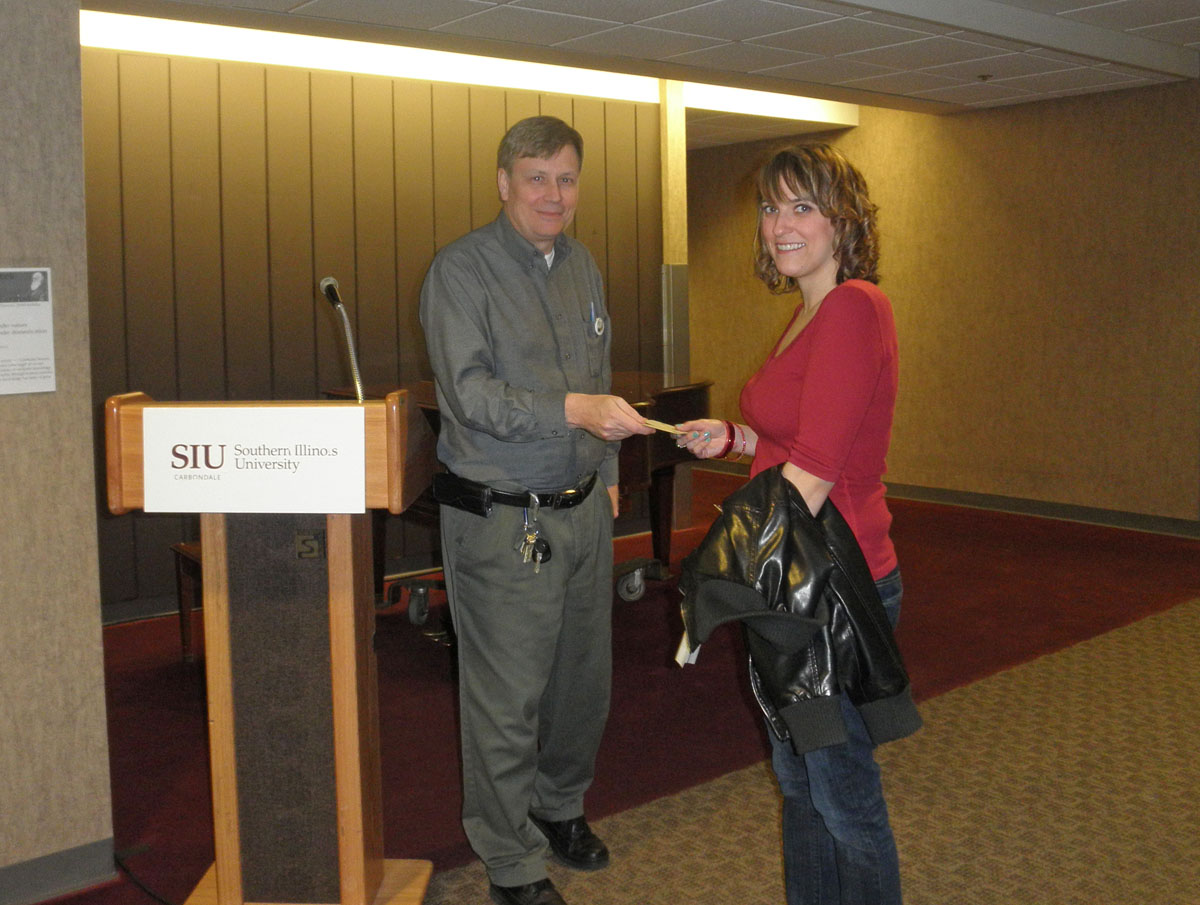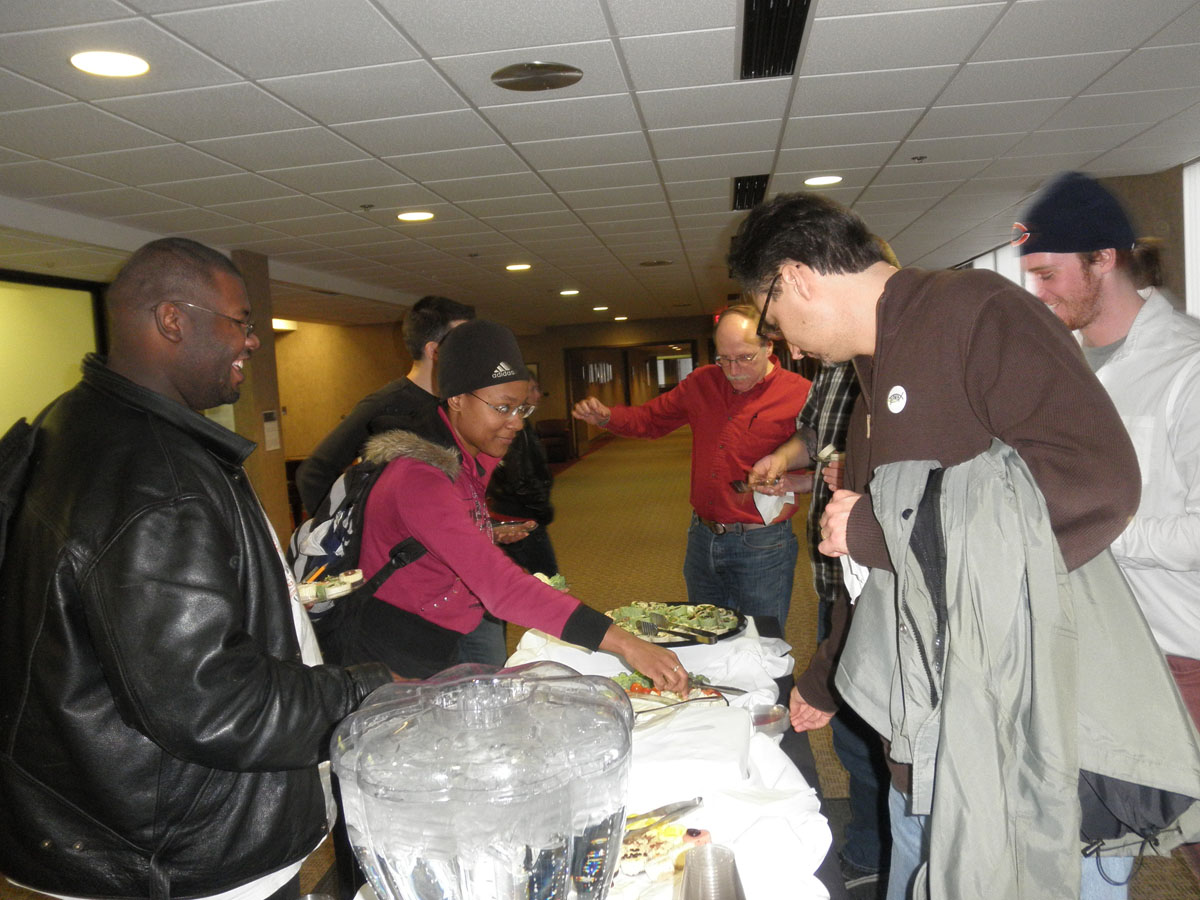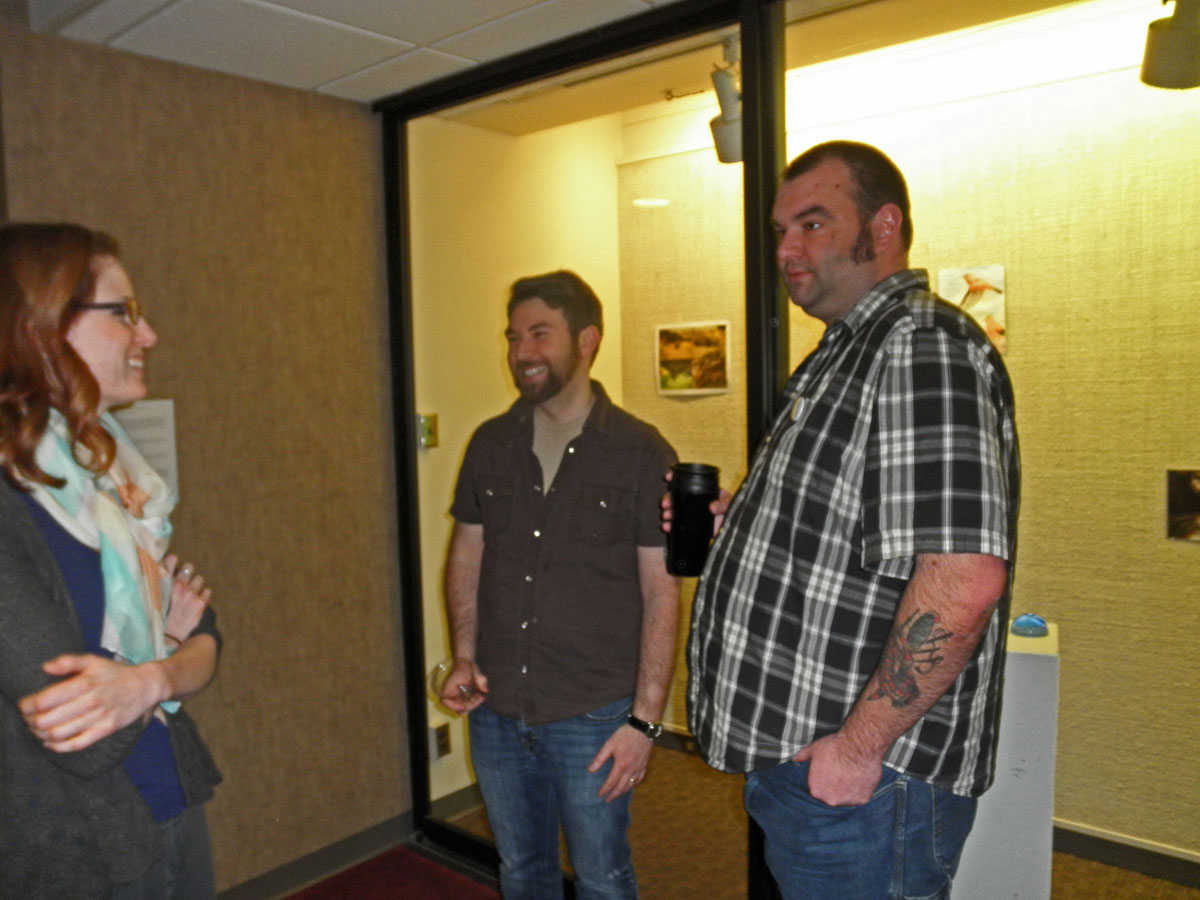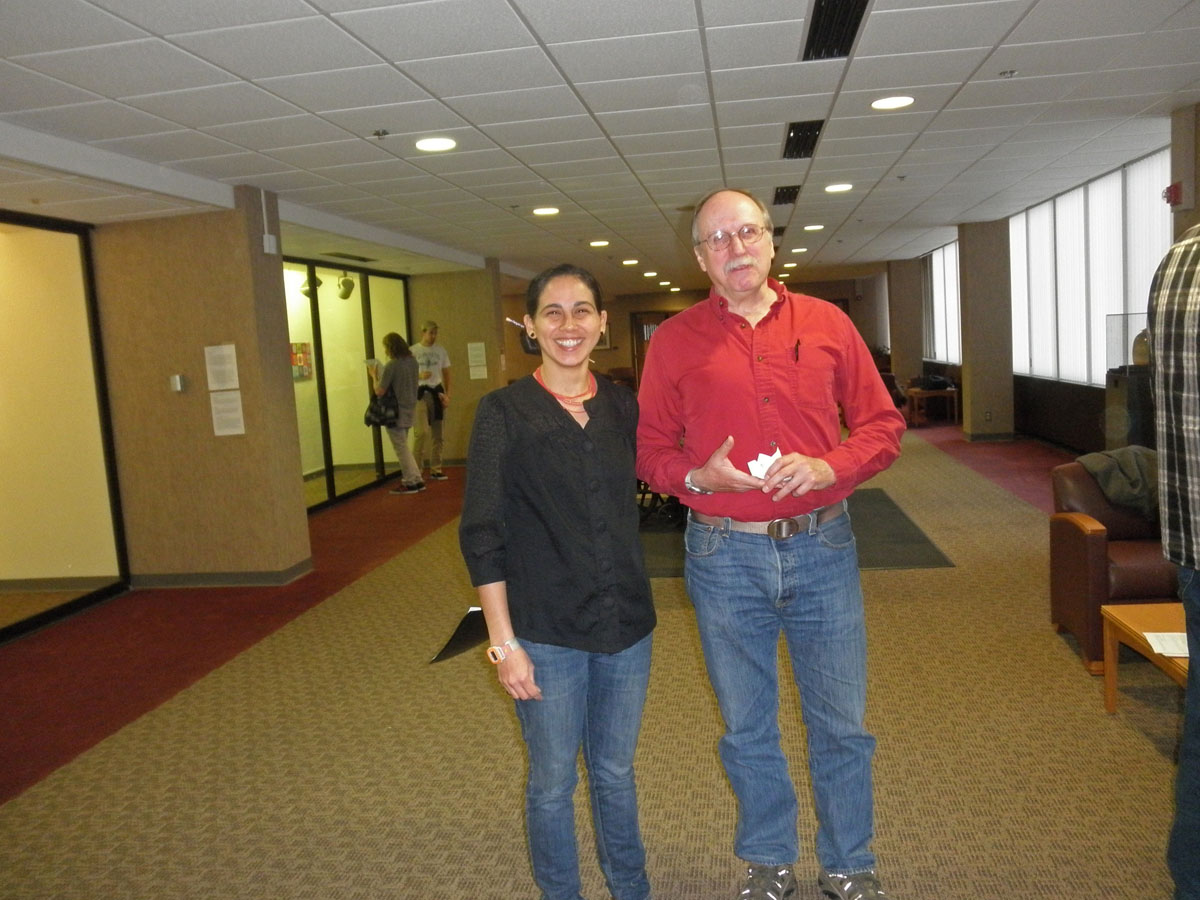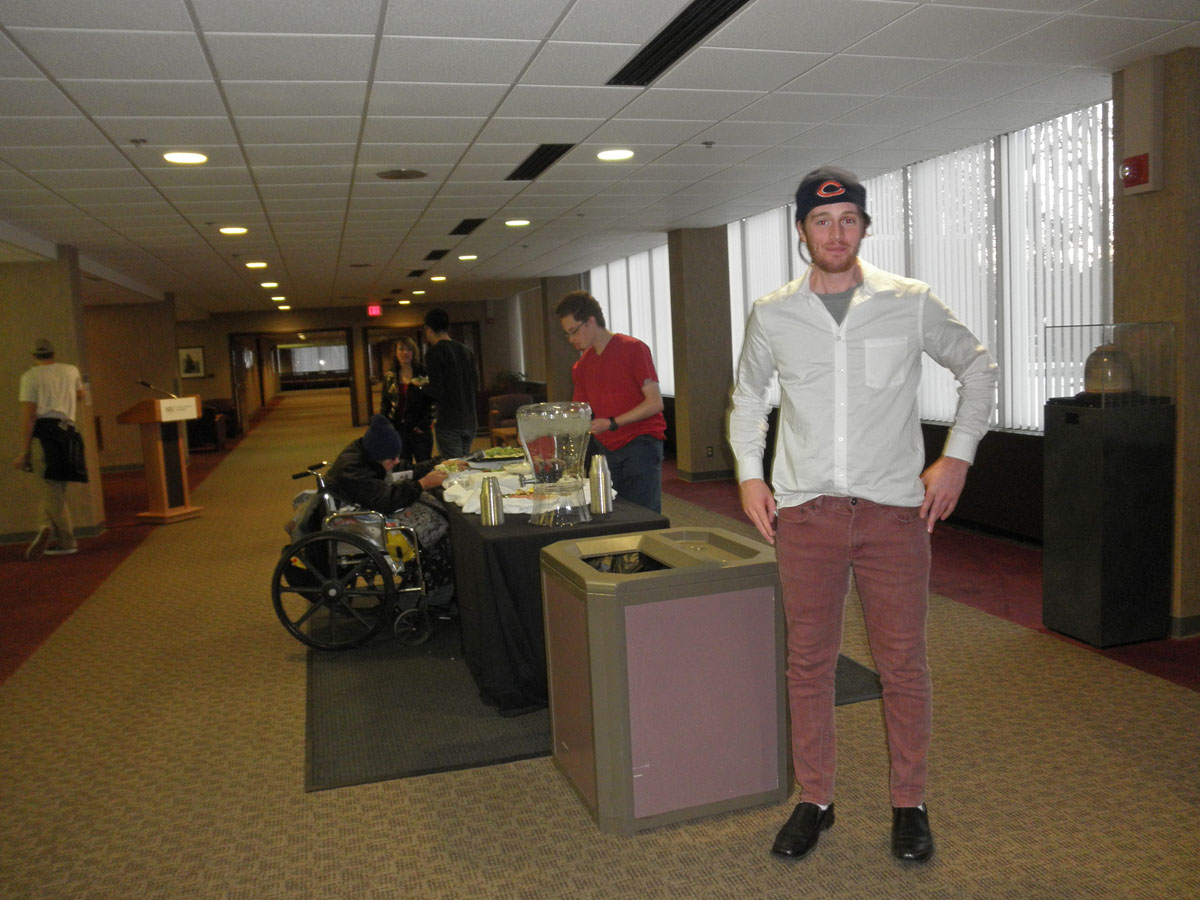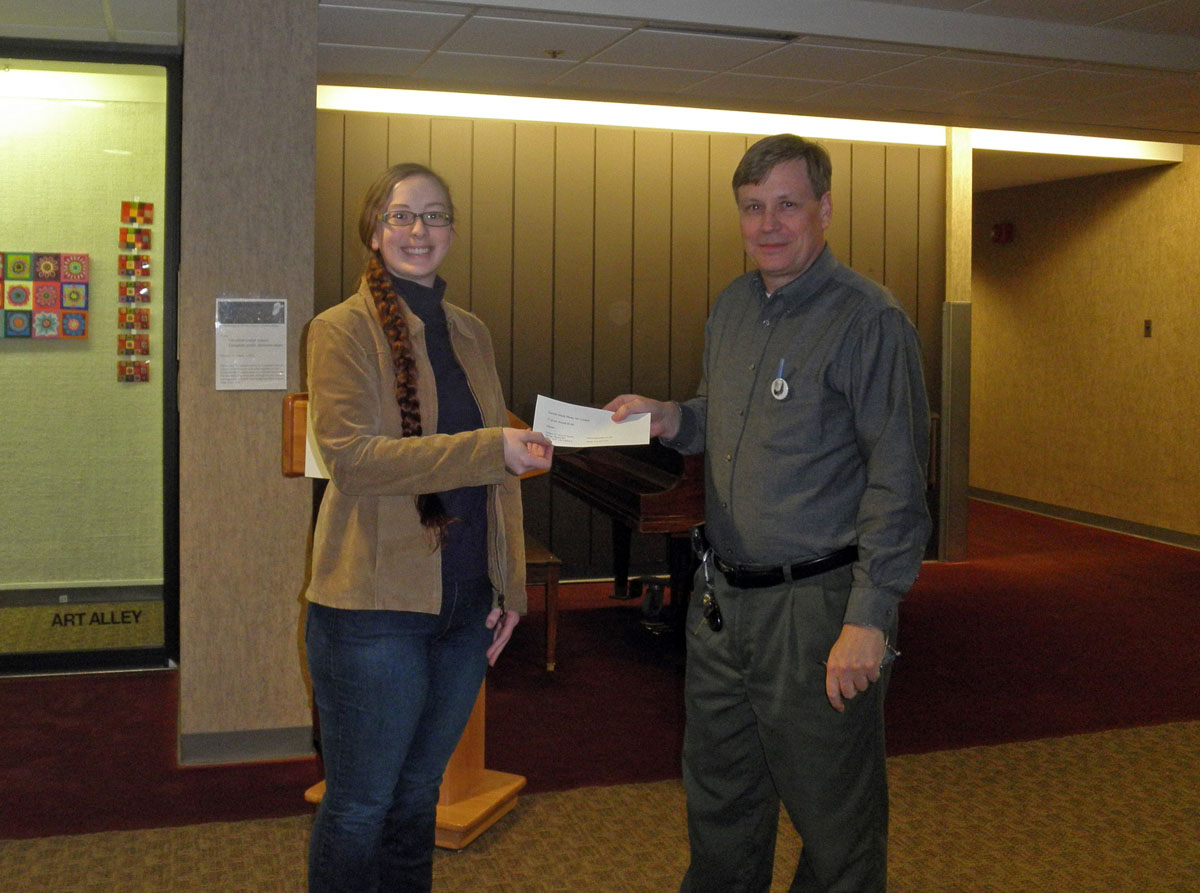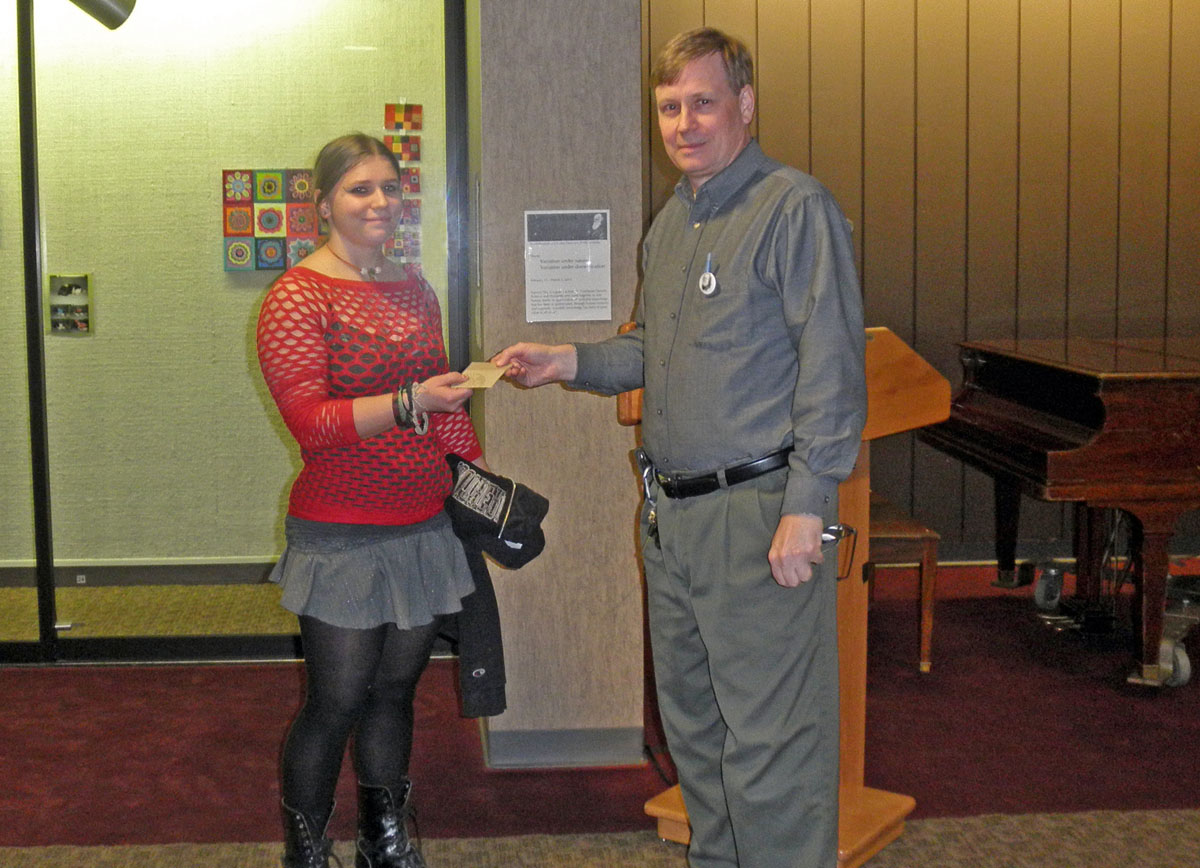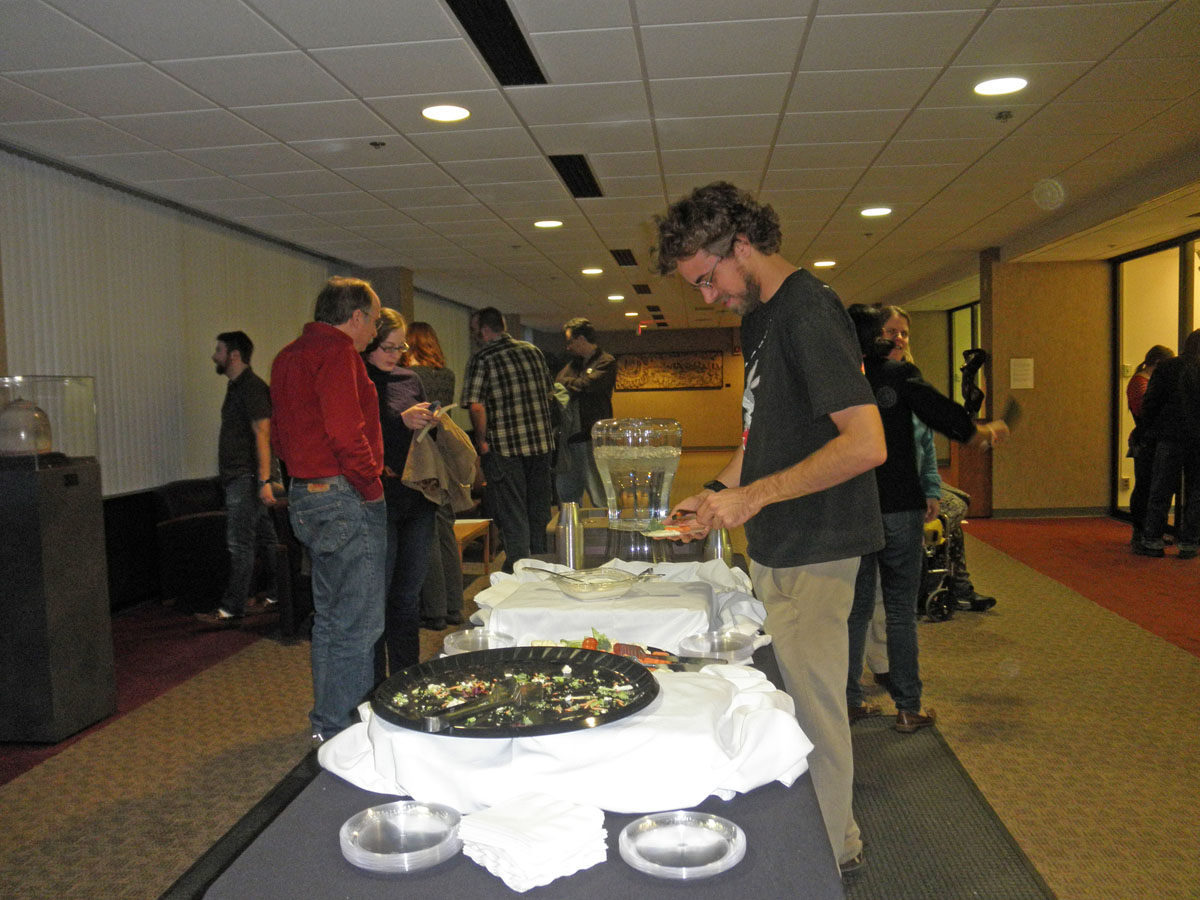| 1 |
Sketches of two whales
Meaghan Petix
Plant Biology |
 |
| 2 |
Eyes wide open
Eva Kwiatek
Zoology
The double-striped thick knee is a special bird that relies on its
camouflage to conceal itself from predators. The bird has the
ability to fly, but chooses to avoid it as much as possible to
keep its eyes on food. It has two “knees” that bend both forward
and backward giving it the ability to position itself comfortably
no matter the position. The call it gives to find a mate is ear
drum piercing and effective. |
 |
| 3 |
Caracoles
Amelia Merced
Plant Biology
These shells were found on the beach, in an area of less than 1m2
apart. How can you explain that no one of them is alike? Variation
is the result of different genotypes and exists in nature to
provide the primary material for selection and evolution to take
place. |
 |
| 4 |
Stretch
Jacqueline Pompa
Aquatic Ecology, Radbound University Nijmegen, Netherlands
This is a picture of a dragonfly struggling to leave its aquatic
skin and start a terrestrial life in the Swiss Alps. It
illustrates variation in life forms and existence in nature, but
also the capability of species to have beautiful varieties of
natures during their life cycle. |
 |
| 5 |
Trojan corn
Beth Martell
Morris Library, Special Collections
"We are face to face with a corn that won't process the way it's
processed for the last 150 years ...We have a corn that ruins food
for starch uses. If it goes into shipments to Japan, if you were
the Japanese, would you want to be buying from an area that grew
this corn, that approved this corn?" |
 |
| 6 |
Yakka: Stretch for the sun
Stephen Ebbs
Plant Biology
The giant inflorescences of yakka (Xanthorrhoea johnsonii) bolt
towards the sun in a costal wetland in Australia. The height
of each inflorescence stalk varies from plant to plant, as does
the number of flowers on each stalk. Each inflorescence
usually extends vertically towards to sun, but occasionally
certain individual plants produce inflorescences with unique bends
or twists (one example appears in the extreme right in the
background with a 30 degree angle bend near the tip, another in
the right foreground). |
 |
| 7 |
Man’s morph (Albino reticulated
phyton)
Stephanie Jaros
Zoology
In domesticated herp culture, many enthusiasts have utilized
recessive genes to create different morphs of snakes, lizards,
turtles, and so on. Man has selectively breed to create an
interesting variety of herps on the market today. One of the
biggest and well known morphs would be leucism and albinos. One
might say their unique lack of color started it all. |
 |
| 8 |
Tree
Josh Freeman
Glass
This piece is about humanity’s negative impact on the environment. |
 |
| 9 |
Variation in life history of
neotropical amphibians
Amanda Rugenski
Zoology
The photographs represent the variation in life history stages of
endangered amphibians that are dependent on both aquatic and
terrestrial habitats. The top right photo is of a larval tadpole
(Smilisca), and the top left of a metamorph before emergence
(Lithobates). Both of these photos were taken underwater in their
natural habitat. The bottom right is of a froglet that is
direct development and does not go through an aquatic larval phase
but is the same age as the top two photos. The bottom left is an
adult Atelopus. Frogs are awesome! |
 |
| 10 |
Preying for a meal
Elliott Zieman
Zoology
This mantis shows a body plan that is unique to mantids. She has
specially adapted captorial forelegs for grasping prey as well as
complex compound eyes for detecting and accurately acquiring prey. |
 |
| 11 |
Honeycreepers
Alexandra Davis
Anthropology (Zoology minor)
This piece exemplifies how geographic isolation, such as that
created by the islands of Hawaii, contributes to speciation. In
this case, each bird, the apapane, i’iwi and akepa. Has a unique
beak that suits a diet specific to their geographic region. |
 |
| 12 |
Life suspended in water drops
Ashpey Pedone
Glass
These half spheres have images of diatoms on the bottoms. Diatoms
are ubiquitous and live in almost every body of water. These
images are samples from three different locations, showing the
drastically different environments diatoms thrive in: Baikal Lake,
with some of the oldest organisms in it; Beowulf spring, that has
about a pH of 2; and Biscayne Bay, Florida. In these images there
is also a large variety of different diatoms that live in the same
location.
|
 |
| 13 |
Waiting for the cover of snow
Queen of the savannah
Stripes behind bars
Eva Kwiatek
Zoology
The snow leopard was made for its environment. It has large paws
to keep a grip in the snow, the paws also have fur between each
digit to keep out the cold. Giant fangs fill the mouth of this
cat, though it never roars. Its legs are meant for pouncing 20
feet high and nearly 40 feet horizontally. Its beautiful tail
measures twice as long as its body to be able to wrap it around
itself to keep warm in the high slope. If its coloring isn’t
enough to show its strength in attacking prey, the 200 meters it
can um at a time to chase down pray would change your mind.
The brilliance of a lioness is proven in her hunting. The stealth
that she uses to stalk prey faster than herself gives her an edge.
Her vision that “shines” in the dark makes her a dangerous
predator. Her forward facing eyes, ready for the pounce to end a
life.
Domestication of a wild animal isn’t a process that happens
overnight. Tigers with their beautiful stripes help them blend
into their homeland, but in an enclosure, they’re out of their
element. Their keen sense of smell used to judge and follow their
captors. Her stripes may be different from her sister’s, but they
both share the sense malice in the human smell. |
 |
| 14 |
Mary The Oracle
Troy "Scat" Patterson
Art and Design
This piece is part of a series of works entitled "Unladylike", in
which a body of art portrays the good that comes from something
that is shamed in today's society. The "Unladylike" series shows a
positive, optimistic perspective towards women on the many things
that most people in this century subconsciously view as negative;
such as: single-mother households, change in women's fashion,
women with tattoos and piercings, exotic dancers and adult film
stars, and women's consumption of drugs and alcohol. The title and
concept of this piece was inspired by a movie written and directed
by Andy and Lana Wachowski entitled, The Matrix, in where a
computer hacker learns from mysterious rebels about the true
nature of his reality and his role in the war against its
controllers. In this war, enslaved humans are kept docile within
the "matrix"- a simulation of the world as it was in 1999. In The
Matrix, the Oracle (a character played by a woman named Mary
Alice) is a "program designed to investigate the human psyche"
-allowing the matrix to become more accustomed for the majority of
the human population to accept. In relation to The Matrix, "Mary
the Oracle" is a rebel woman-tree growing out of the earth, made
up of flowers and different strands of cannabis- playing on a
perspective where the marijuana woman-tree is portrayed as a
natural substance not equally accepted in today's society, but
however, is still growing and staying alive in a world that is
stuck on the negative marijuana myths put forth by President Nixon
in 1972. |
 |
| 15 |
Poplars on Poplar
Jeremy Graham
Plant Biology
This piece depicts variation of leaf shape within the “pop-u-lar”
Poplar trees from different geographic ranges. In this case
one of the species is commonly called a Poplar but is actually a
member of the Magnolia family, thus illustrating variation within
proper naming. It is also meant to represent the variety of
domestic uses of Poplar trees, in this case as decoration.
From top left moving clockwise the species are P.
tremuloides
(trembling aspen), P.
trichocarpa (black cottonwood), Liriodendron
tulipefera (tulip poplar), and P.
alba (white poplar). |
 |
| 16 |
Third Eye
Adam Chupp
Plant Biology
The false eye mimicry seen here is somewhat rare among insect
larvae. However, this defensive strategy is common among larvae in
the genus Papilio. This Papilio palamedes (Palamedes swallowtail)
larva is in its fourth instar and nearly ready to pupate. The
false eye and swollen thorax draw attention away from the actual
head, which is only completely revealed during feeding.
Interestingly, the appearance of larvae during earlier stages
mimics that of bird droppings. Therefore, this photo illustrates
the highly adapted morphological variations of individual life
stages. |
 |
| 17 |
Wolf to Woof– Wild nature can
be domesticated
Uday Kumar Chintapula
Biomedical Engineering
This picture shows the power of domestication on the wild nature.
Two of the different species exist in symbiosis. We can see the
picture of a man with his dog at a lakeside before a violent
thunderstorm where the sky was lit by the red light produced by
the conjunction of Sun’s rays and clouds. A report published in
Nature compared the DNA of 12 gray wolves with 60 dogs (including
14 different breeds) and found there were key differences which
allowed dogs to digest carbohydrates far more easily. The presence
of changes to starch and sugar-processing genes would have allowed
early dogs to make the most of the scraps they could scavenge from
human settlements, helping them to thrive despite abandoning the
pack lifestyle. The other scientists have suggested that these
genes may have become adapted after the DOMESTICATION of dogs as
the carb heavy diet promoted the specialization of the
carbohydrate digestion genes. In context to ‘Variation under
domestication’, we have to question ourselves whether the genes
are altered accordingly to adapt the domestication (food,
lifestyle, etc. ) or Domestication brings the change in genes.
Reference: Los Angeles Times – Science January 23, 2013 |
 |
| 18 |
Cetaceous leporidae, ‘Large Sea
Hare’
Robin Gordon
Metalsmithing
The large sea hare (Cetaceous leporidae) is the genetic
manipulation of the humpback whale and large land hare. In
similarity with its baleen whale cousins, the sea hare is a social
mammal and travels in pods. Smaller then one of the larger rorqual
species, adults range in length from 8–12 meters and weigh
approximately 30,000 kilograms. The sea hare is classified a
Domesticated Variation under the Treatise of Biotechnology. This
is due to the dependency the animal has on the creator to survive.
This new species lacks the instinctual behaviors of its cousins.
Although it may mate and occasionally give live birth, mothers
regularly abandon the young. One species in history that was used
to label such dependency was the Whooping Crane. This large bird
found in North America declined in population and would have
become extinct by the mid 1950’s if conservation efforts had not
begun. By the early 2000’s there were close to 500 living birds.
These cranes hatched in captivity, would reportedly lay eggs that
they would later abandon to never hatch. Unfortunately, scientists
and behaviorists never did solve how to make the population of the
Whooping Crane self-sufficient. Government funding cuts in the
2050’s led to the eventual extinction of the crane by the year
2114. The last Whooping Crane died on September 1, 2114, at the
Cincinnati Zoo. The Large Sea Hare seems to be an unfortunate
exercise of geneticists to show off their capability in genetic
craft if not forethought. |
 |
| 19 |
Variation under domestication
(strawberries)
Lily Glaeser
Plant Biology
Wild strawberries and agricultural strawberries differ in many
ways. Demonstrated here, the color of wild strawberries is much
darker. The agricultural strawberry is much larger with greenish
seeds and a more cordate appearance. |
 |
| 20 |
Bovine breeding
Eva Kwiatek
Zoology
The many years of domestication of cattle has led to the want for
a more perfect beast. The years have proven that hybrids vigor
makes for a larger animal with the selection of two different
animals. These breeding techniques and consumer demand have lead
to the creation of the Hereford/Angus cross. It’s no longer a
choice of need, but want.
|
 |
| 21 |
Pepo who need Pepo
Dan Nickrent
Plant Biology
These gregarious gourds and pompous pumpkins shown here represent
many cultivated varieties of one species, Cucurbita pepo
(Cucurbitaceae). These fruits were on display at the Missouri
Botanical Garden (St. Louis) in October of 2004. Fossil fruits and
seeds of Cucurbita date back at least 10,000 years from Mexico to
northern South America, possibly the oldest records for humans use
of any plant. The reasons why are straightforward. Not only
do the fruits produce edible flesh and seeds, but once that is
eaten, the hard rind can be dried and used as a container to carry
water, store food, etc. The plants are easily grown in warm
climates, and this must have prompted the ancient plant breeders
to “tinker” with the genetics. And how the genetic potential of
these plants has been exploited! The photo shows the
incredible range of size, shape and color that has been achieved
by artificial selection, a process that Darwin elegantly showed,
through many examples, that is not very different from natural
selection. |
 |
| 22 |
Cats of different “Miu’s”
Julie Driebergen
Zoology
This piece illustrates Variation Under Domestication. The people
of ancient Egypt were the first to domesticate cats because of
their need to control pests in their crops. They even viewed them
as Gods and Goddesses. They referred to them as miu or muit
meaning he or she who mews. If it were not for the “Egyptian” cat,
people would not have pet cats. The “Egyptian” cat descended
from the African Wild Cat. Today, there are many breeds of cats
with various fur colors and types, and body structures. Some are
larger than the original domesticated cat while others are
smaller. These changes occurred due to selective breeding and
artificial selection due to the various environments and
situations humans placed cats into. Depicted in the art piece are
the African Wild Cat of ancient Egypt and its ancestors: the Maine
Coon Cat, the Siamese Cat, the Sphynx Cat, the Persian Cat, and
the American Longhair cat. These cats have diverse characteristics
due to man’s interference.
|
 |
| 23 |
Jim, Jim's Auto
Nathan Fortmeyer
Department of Cinema and Photography
This photograph of Jim, the proprietor of "Jim's Auto," depicts a
man in his milieu: a cluttered, expansive automobile repair shop.
Jim has amassed an encyclopedic knowledge of automobiles, and his
shop is a testament to his skills, knowledge, and craft. The more
humans depend upon automobiles to navigate their environment, the
more Jim's business will thrive. Jim has adapted his experience to
a specific niche, and exhibits profound creativity and
adaptability when fixing automobiles; as a result, Jim is well
equipped to contend with the myriad variations in make, model, and
design of automobile.
|
 |
| 24 |
Spring, Summer, Fall, and
Winter
Diane Harshbarger
Plant Biology
Humans love their dogs, and dogs will do most anything to please
their humans. Although this collage may seem silly, it is true
that humans are in control of the variation we see in domesticated
creatures. Domestication of dogs by human owners has resulted in
various forms of apparel to provide comfort during inclement
weather. Who knows, over time domesticated dogs may evolve into
nearly hairless organisms dependent on clothing, much like us! |
 |
| 25 |
Layered Abstraction
Kathy Hytten
Education Administration and Higher Education
In this piece, I play with variations on shape and color in
creating a variety of abstract flower paintings. I started by
painting 12 colored panels and then layered different colors and
shapes on top as the paint dried. Even using a limited number of
colors and shapes, the possibilities for variety are
infinite. While abstract, the final painting represents one
vision of natural variety. The accompanying photographs represent
the evolution of that variation. |
 |
